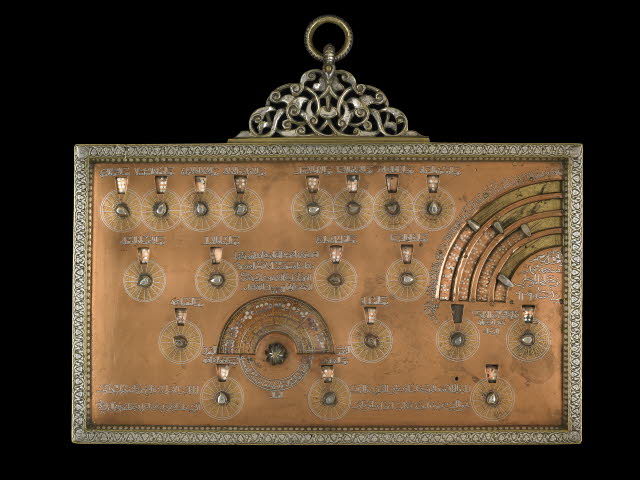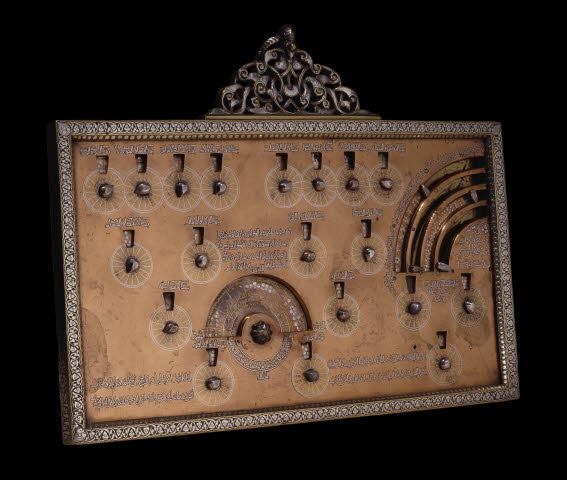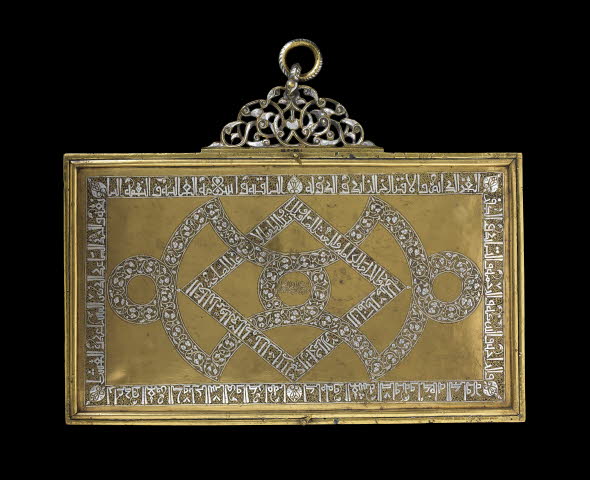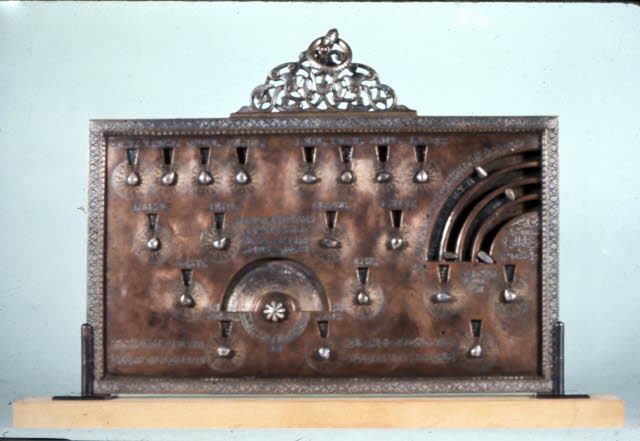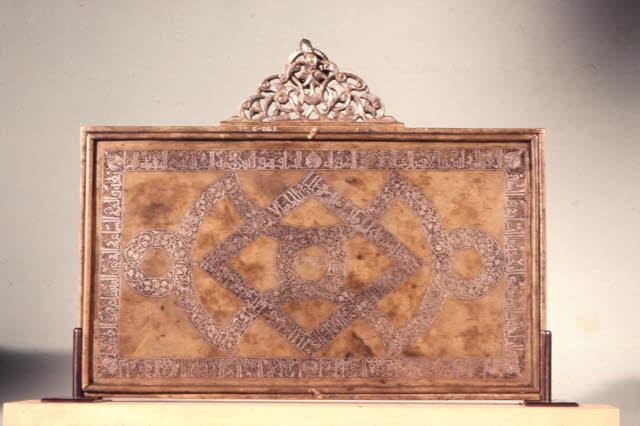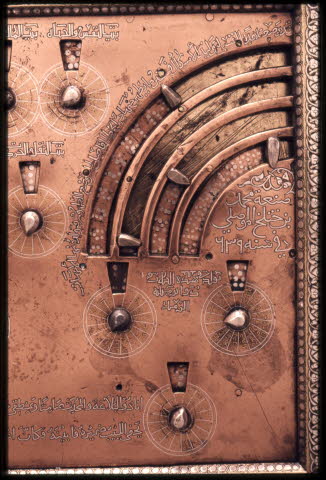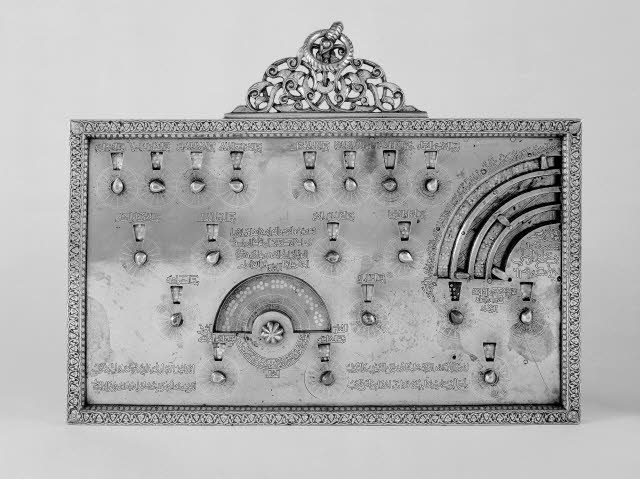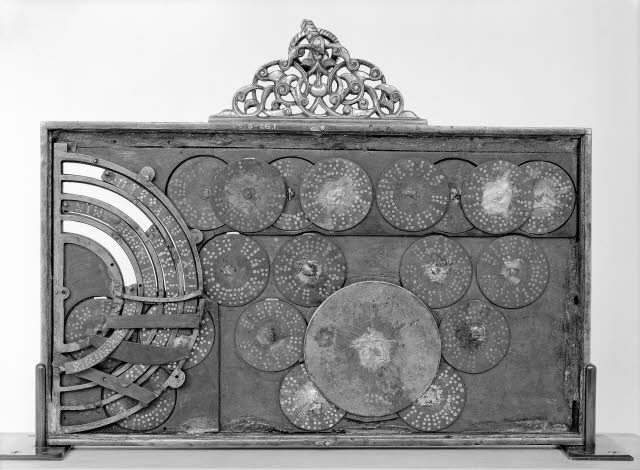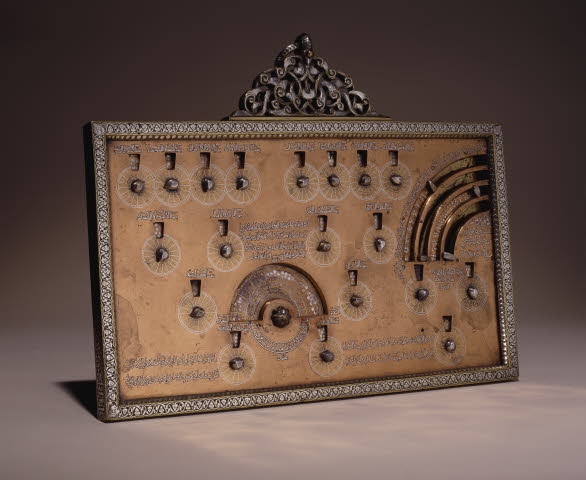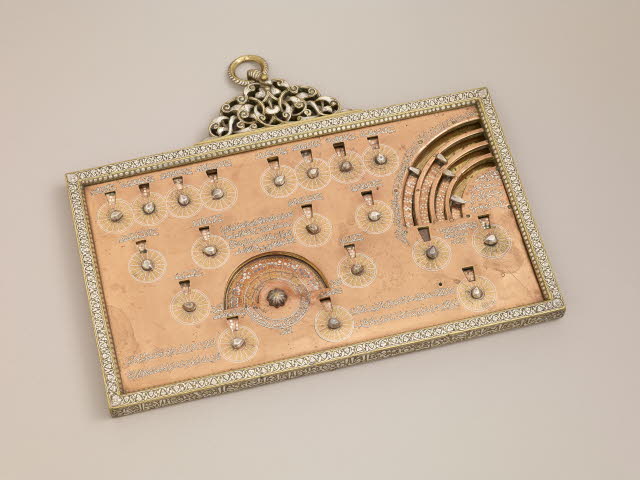Divination equipment
BackDescription:
Copper alloy geomantic instrument inlaid with gold and silver in four main pieces: front plate, back plate, frame, and suspensory device (kursi). Smaller parts include 20 circular dials and four semi-circular sliding arcs attached to the back of the front plate. The front plate is recessed into the frame in the manner of a picture frame. The back plate sits within the back of the frame and is held in place by two small pins. The front plate has several inscriptions and geomantic figures. The frame is inscribed with a poem and decorated with a stem and trefoil pattern on the front. The suspensory device is triangular and in the form of an elaborate vegetal pattern with an incised ring. The back plate is bordered by an inscription with a vegetal and arabesque background. The centre of the black plate has an intertwined band filled with a vegetal motif overlaid with a diamond shaped inscription.
Object type: | divination equipment |
Museum number: | 1888,0526.1 |
Culture/period: | Middle Islamic |
Date: | 1241-1242 (AH 639) |
Production place: | Made in: Syria (Probably Damascus) |
Materials: | brass, gold, silver |
Technique: | engraved, inlaid |
Dimensions: | Height: 26.80 cm Width: 33.60 cm Depth: 1.70 cm |
Inscriptions: | Inscription details: signature and date (front of device in upper right-hand corner) in Arabic in naskh script Inscription quoted: صنعة محمد بن ختلخ الموصلى في سنة ۶۳۹ Inscription translation: The work of Muhammad ibn Khutlukh al-Mawsili in the year 639. Inscription note: All translations from Savage-Smith, E. and M. Smith (2004). Inscription: Inscription details: inscription in Arabic in naskh script Inscription quoted: في نوبت محمد المحتسب البخارى Inscription translation: In the possession of Muhammad al Muhtasib al-Bukhari. Inscription note: Because this inscription is not inlaid and different from the others, it is unclear whether or not the owner named commisioned the work or owned it after its manufacture. Inscription: Inscription details: inscription (nineteen small circles on front plate) in Arabic in Kufic script Inscription quoted: Inscription note: For Arabic, see 'Inscriptions' image, Number 3. Each of the nineteen small circles has an identical inscription. The circles are divided into sixteen sections, not including the open window. Each section contains a single word. Inscription: Inscription details: inscription (above sixteen of the nineteen small circles on front panel) in Arabic in Kufic script Inscription quoted: Inscription translation: Reading from right to left: The house of soul and life The house of property and wages The house of brothers and sisters The house of fathers and mothers The house of offspring and children The house of illness and disease The house of women and sexual matters The house of slaughter and death The house of movement and changes The house of power and glory The house of hope and expectations The house of emenies and envious people The house of the questioner The house of the object of the inquiry The house of the result The house of the result of the result Inscription note: For Arabic, see 'Inscriptions' image, Number 4.The inscriptions form the sixteen positions or houses of the geomantic tableau. Inscription: Inscription details: inscription (lower right of front panel, between three small circles and four arcs) in Arabic in Kufic script Inscription quoted: تولد في هذه الحلات دوائر مثلثة الرمل Inscription translation: In these locations circles generate the geomantric triplet. Inscription note: For الحلات E. Savage-Smith interprets as المحلات. Inscription: Inscription details: inscription (Upper right of front panel, over four arcs) in Arabic in naskh script Inscription quoted: Inscription translation: We have placed these arcs in order to generate the figures, and so those that appear next to the seperating line at the point of visibility are to be considered, and then from them you generate the Mothers. Inscription note: For Arabic, see 'Inscriptions' image, Number 6. Inscription: Inscription details: inscription (Above large central dial on front panel) in Arabic in Kufic script Inscription quoted: Inscription translation: We have established this circle so that you might learn from it the correspondences of the forms of the figures with the forms of the lunar mansions, rising and setting. Thereupon the power to interpret might belong to it, but God knows best. Inscription note: For Arabic, see 'Inscriptions' image, Number 7. Inscription: Inscription details: inscription (Around large central dial on front panel) in Arabic in Kufic script Inscription quoted: Inscription translation: North, South, East, West. Inscription note: Cardinal points in their usual positions. For Arabic, see 'Inscriptions' image, Number 8. Inscription: Inscription details: inscription (Below central dial on front panel) in Arabic in Kufic script Inscription quoted: Inscription translation: From my intricacies there comes about insight superior to books concerned with the study of the art. Inscription note: For Arabic, see 'Inscriptions' image, Number 9. Inscription: Inscription details: inscription (Large central dial on front plate) in Arabic in Kufic script Inscription quoted: Inscription note: For Arabic and English translation, see 'Inscriptions' image, Number 10. Inscription: Inscription details: inscription (lower right of large dial on front plate) in Arabic in naskh script Inscription quoted: Inscription translation: I am the possessor of eloquence and the silent speaker and through my speech [arise] desires and fears. The judicious one hides his secret thoughts, but I disclose them, just as if hears were created as my parts. Inscription note: For Arabic, see 'Inscriptions' image, Number 11. Poem in kamil metre. Inscription: Inscription details: inscription (lower left of front plate, left of dial labelled 'house of the result of the result') in Arabic in naskh script Inscription quoted: Inscription translation: I am the revealer of secrets; in me are marvels of wisdom and strange and hidden things. But I have spread out the surface of my fave out of humility, and have prepared it as a substitute for earth. Inscription note: For Arabic, see 'Inscriptions' image, Number 12. Poem in kamil metre. Inscription: Inscription details: inscription (frame) in Arabic in naskh script Inscription quoted: Inscription translation: Examine the tablet and memorize it, for in it There is meaning from the tablet [of God in Heaven] when it was marked with the pen. It shows hidden secrets of the unseen which were determined from time immemorial. It agrees with geomancy in meaning but differs from it because it generates the figures from nothing. The tablets of Moses were made valuable by what wisdom and authority God gave them. But it is sufficient honour for it that a hand touched it which is superior to the hands of men in strength and nobleness of character. Inscription note: For Arabic, see 'Inscriptions' image, Number 13. Poem in basit metre. Inscription: Inscription details: inscription (rectangular border of back plate) in Arabic in Kufic script Inscription quoted: Inscription translation: Everlasting glory, continual and abiding prosperity, constant power, supreme peace, perpetual well-being, increasing good fortune, favourable fate, a comfortable manner of life, sufficient satisfaction, peace of mind, blessing, compassion, support and success. Inscription note: For Arabic, see 'Inscriptions' image, Number 14. Inscription: Inscription details: inscription (centre diamond on back plate) in Arabic in naskh script Inscription quoted: Inscription translation: Everlasting glory, a long unimpaired life, outstanding character, efficacious power, fortunate omens, complete honour, a pure manner of life, support and victory over the enemies for its owner. Inscription note: For Arabic, see 'Inscriptions' image, Number 15. |
Location: | 47 |
Exhibition history: | Exhibited: 2016-2017 20 Oct-12 Feb, Oxford, Ashmolean Museum, Power & Protection Art and the Supernatural in the Islamic World 2001-2002 22 Oct-10 Mar, Paris, Institut du Monde Arabe, 'L'Orient de Saladin au temps des Ayyoubides' |
Subjects: | magic |
Acquisition date: | 1888 |
Curator's comments:
Geomancy is a popular form of divination (seeking knowledge through supernatural means) practised across the Islamic world. In Arabic, it is known as 'ilm al-raml', literally ‘the science of the sand.’ In this ancient practice, the position of randomly thrown grains of sand answered specific questions put to the geomancer by the client. Enquiries often concerned matters of daily life, such as the health of a child, infidelity of a spouse or success of a business dealing. These principles were transferred to this unique instrument, whose spinning dials reveal clusters of dots which can be similarly interpreted.The inscriptions on the back of the instrument confer blessings, good fortune and prosperity on its owner. The maker, Muhammad ibn Kutlukh al-Mawsili is from a family of prolific metalworkers originating in Mosul. He also made an incense burner now in the Museum of Islamic Art, Doha, Qatar, MW.584.2009. The inscription on the incense burner states that it was made in Damascus. The owner's name was previously read as Muhammad al-Muhtasib al-Bukhari but has been re-read as Muhammad al-Muhtasib al-Najjari (for the Mosul 'school' of metalwork see J. Raby 'The principle of Parsimony and the problem of the "Mosul school of Metalwork" in V.Porter and M. Rosser-Owen (eds.) Metalwork and Material Culture in the Islamic World (London I.B.Tauris, 2012, table I.I a)
